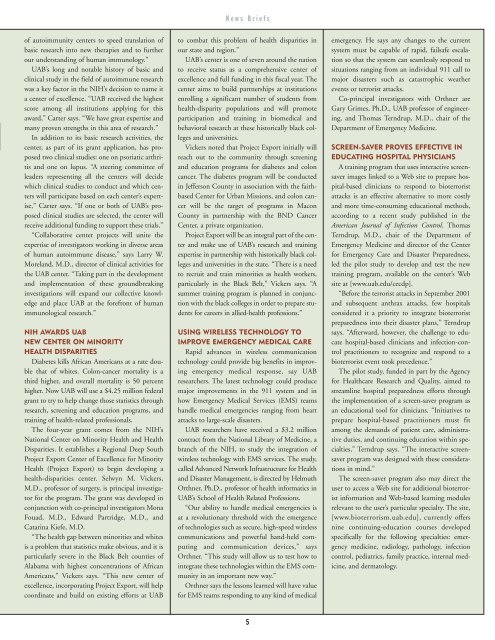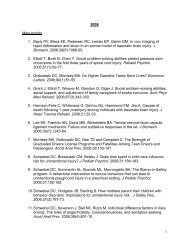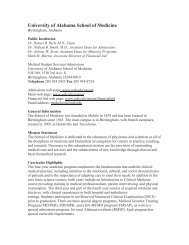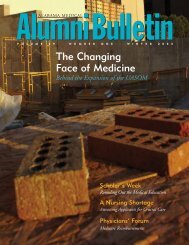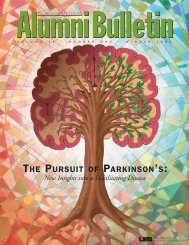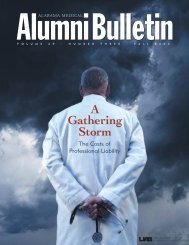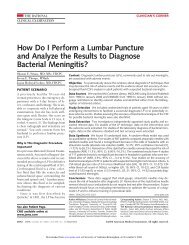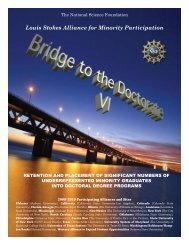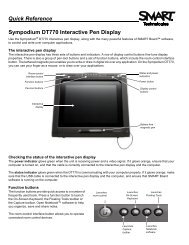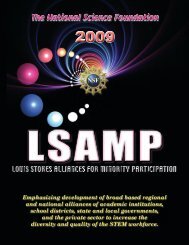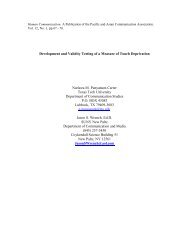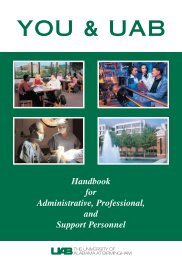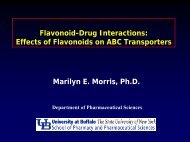uasom doctors uasom doctors - University of Alabama at Birmingham
uasom doctors uasom doctors - University of Alabama at Birmingham
uasom doctors uasom doctors - University of Alabama at Birmingham
You also want an ePaper? Increase the reach of your titles
YUMPU automatically turns print PDFs into web optimized ePapers that Google loves.
News Cover Briefs Story<br />
<strong>of</strong> autoimmunity centers to speed transl<strong>at</strong>ion <strong>of</strong><br />
basic research into new therapies and to further<br />
our understanding <strong>of</strong> human immunology.”<br />
UAB’s long and notable history <strong>of</strong> basic and<br />
clinical study in the field <strong>of</strong> autoimmune research<br />
was a key factor in the NIH’s decision to name it<br />
a center <strong>of</strong> excellence. “UAB received the highest<br />
score among all institutions applying for this<br />
award,” Carter says. “We have gre<strong>at</strong> expertise and<br />
many proven strengths in this area <strong>of</strong> research.”<br />
In addition to its basic research activities, the<br />
center, as part <strong>of</strong> its grant applic<strong>at</strong>ion, has proposed<br />
two clinical studies: one on psori<strong>at</strong>ic arthritis<br />
and one on lupus. “A steering committee <strong>of</strong><br />
leaders representing all the centers will decide<br />
which clinical studies to conduct and which centers<br />
will particip<strong>at</strong>e based on each center’s expertise,”<br />
Carter says. “If one or both <strong>of</strong> UAB’s proposed<br />
clinical studies are selected, the center will<br />
receive additional funding to support these trials.”<br />
“Collabor<strong>at</strong>ive center projects will unite the<br />
expertise <strong>of</strong> investig<strong>at</strong>ors working in diverse areas<br />
<strong>of</strong> human autoimmune disease,” says Larry W.<br />
Moreland, M.D., director <strong>of</strong> clinical activities for<br />
the UAB center. “Taking part in the development<br />
and implement<strong>at</strong>ion <strong>of</strong> these groundbreaking<br />
investig<strong>at</strong>ions will expand our collective knowledge<br />
and place UAB <strong>at</strong> the forefront <strong>of</strong> human<br />
immunological research.”<br />
NIH AWARDS UAB<br />
NEW CENTER ON MINORITY<br />
HEALTH DISPARITIES<br />
Diabetes kills African Americans <strong>at</strong> a r<strong>at</strong>e double<br />
th<strong>at</strong> <strong>of</strong> whites. Colon-cancer mortality is a<br />
third higher, and overall mortality is 50 percent<br />
higher. Now UAB will use a $4.25 million federal<br />
grant to try to help change those st<strong>at</strong>istics through<br />
research, screening and educ<strong>at</strong>ion programs, and<br />
training <strong>of</strong> health-rel<strong>at</strong>ed pr<strong>of</strong>essionals.<br />
The four-year grant comes from the NIH’s<br />
N<strong>at</strong>ional Center on Minority Health and Health<br />
Disparities. It establishes a Regional Deep South<br />
Project Export Center <strong>of</strong> Excellence for Minority<br />
Health (Project Export) to begin developing a<br />
health-disparities center. Selwyn M. Vickers,<br />
M.D., pr<strong>of</strong>essor <strong>of</strong> surgery, is principal investig<strong>at</strong>or<br />
for the program. The grant was developed in<br />
conjunction with co-principal investig<strong>at</strong>ors Mona<br />
Fouad, M.D., Edward Partridge, M.D., and<br />
C<strong>at</strong>arina Kiefe, M.D.<br />
“The health gap between minorities and whites<br />
is a problem th<strong>at</strong> st<strong>at</strong>istics make obvious, and it is<br />
particularly severe in the Black Belt counties <strong>of</strong><br />
<strong>Alabama</strong> with highest concentr<strong>at</strong>ions <strong>of</strong> African<br />
Americans,” Vickers says. “This new center <strong>of</strong><br />
excellence, incorpor<strong>at</strong>ing Project Export, will help<br />
coordin<strong>at</strong>e and build on existing efforts <strong>at</strong> UAB<br />
to comb<strong>at</strong> this problem <strong>of</strong> health disparities in<br />
our st<strong>at</strong>e and region.”<br />
UAB’s center is one <strong>of</strong> seven around the n<strong>at</strong>ion<br />
to receive st<strong>at</strong>us as a comprehensive center <strong>of</strong><br />
excellence and full funding in this fiscal year. The<br />
center aims to build partnerships <strong>at</strong> institutions<br />
enrolling a significant number <strong>of</strong> students from<br />
health-disparity popul<strong>at</strong>ions and will promote<br />
particip<strong>at</strong>ion and training in biomedical and<br />
behavioral research <strong>at</strong> these historically black colleges<br />
and universities.<br />
Vickers noted th<strong>at</strong> Project Export initially will<br />
reach out to the community through screening<br />
and educ<strong>at</strong>ion programs for diabetes and colon<br />
cancer. The diabetes program will be conducted<br />
in Jefferson County in associ<strong>at</strong>ion with the faithbased<br />
Center for Urban Missions, and colon cancer<br />
will be the target <strong>of</strong> programs in Macon<br />
County in partnership with the BND Cancer<br />
Center, a priv<strong>at</strong>e organiz<strong>at</strong>ion.<br />
Project Export will be an integral part <strong>of</strong> the center<br />
and make use <strong>of</strong> UAB’s research and training<br />
expertise in partnership with historically black colleges<br />
and universities in the st<strong>at</strong>e. “There is a need<br />
to recruit and train minorities as health workers,<br />
particularly in the Black Belt,” Vickers says. “A<br />
summer training program is planned in conjunction<br />
with the black colleges in order to prepare students<br />
for careers in allied-health pr<strong>of</strong>essions.”<br />
USING WIRELESS TECHNOLOGY TO<br />
IMPROVE EMERGENCY MEDICAL CARE<br />
Rapid advances in wireless communic<strong>at</strong>ion<br />
technology could provide big benefits in improving<br />
emergency medical response, say UAB<br />
researchers. The l<strong>at</strong>est technology could produce<br />
major improvements in the 911 system and in<br />
how Emergency Medical Services (EMS) teams<br />
handle medical emergencies ranging from heart<br />
<strong>at</strong>tacks to large-scale disasters.<br />
UAB researchers have received a $3.2 million<br />
contract from the N<strong>at</strong>ional Library <strong>of</strong> Medicine, a<br />
branch <strong>of</strong> the NIH, to study the integr<strong>at</strong>ion <strong>of</strong><br />
wireless technology with EMS services. The study,<br />
called Advanced Network Infrastructure for Health<br />
and Disaster Management, is directed by Helmuth<br />
Orthner, Ph.D., pr<strong>of</strong>essor <strong>of</strong> health inform<strong>at</strong>ics in<br />
UAB’s School <strong>of</strong> Health Rel<strong>at</strong>ed Pr<strong>of</strong>essions.<br />
“Our ability to handle medical emergencies is<br />
<strong>at</strong> a revolutionary threshold with the emergence<br />
<strong>of</strong> technologies such as secure, high-speed wireless<br />
communic<strong>at</strong>ions and powerful hand-held computing<br />
and communic<strong>at</strong>ion devices,” says<br />
Orthner. “This study will allow us to test how to<br />
integr<strong>at</strong>e these technologies within the EMS community<br />
in an important new way.”<br />
Orthner says the lessons learned will have value<br />
for EMS teams responding to any kind <strong>of</strong> medical<br />
emergency. He says any changes to the current<br />
system must be capable <strong>of</strong> rapid, failsafe escal<strong>at</strong>ion<br />
so th<strong>at</strong> the system can seamlessly respond to<br />
situ<strong>at</strong>ions ranging from an individual 911 call to<br />
major disasters such as c<strong>at</strong>astrophic we<strong>at</strong>her<br />
events or terrorist <strong>at</strong>tacks.<br />
Co-principal investig<strong>at</strong>ors with Orthner are<br />
Gary Grimes, Ph.D., UAB pr<strong>of</strong>essor <strong>of</strong> engineering,<br />
and Thomas Terndrup, M.D., chair <strong>of</strong> the<br />
Department <strong>of</strong> Emergency Medicine.<br />
SCREEN-SAVER PROVES EFFECTIVE IN<br />
EDUCATING HOSPITAL PHYSICIANS<br />
A training program th<strong>at</strong> uses interactive screensaver<br />
images linked to a Web site to prepare hospital-based<br />
clinicians to respond to bioterrorist<br />
<strong>at</strong>tacks is an effective altern<strong>at</strong>ive to more costly<br />
and more time-consuming educ<strong>at</strong>ional methods,<br />
according to a recent study published in the<br />
American Journal <strong>of</strong> Infection Control. Thomas<br />
Terndrup, M.D., chair <strong>of</strong> the Department <strong>of</strong><br />
Emergency Medicine and director <strong>of</strong> the Center<br />
for Emergency Care and Disaster Preparedness,<br />
led the pilot study to develop and test the new<br />
training program, available on the center’s Web<br />
site <strong>at</strong> [www.uab.edu/cecdp].<br />
“Before the terrorist <strong>at</strong>tacks in September 2001<br />
and subsequent anthrax <strong>at</strong>tacks, few hospitals<br />
considered it a priority to integr<strong>at</strong>e bioterrorist<br />
preparedness into their disaster plans,” Terndrup<br />
says. “Afterward, however, the challenge to educ<strong>at</strong>e<br />
hospital-based clinicians and infection-control<br />
practitioners to recognize and respond to a<br />
bioterrorist event took precedence.”<br />
The pilot study, funded in part by the Agency<br />
for Healthcare Research and Quality, aimed to<br />
streamline hospital preparedness efforts through<br />
the implement<strong>at</strong>ion <strong>of</strong> a screen-saver program as<br />
an educ<strong>at</strong>ional tool for clinicians. “Initi<strong>at</strong>ives to<br />
prepare hospital-based practitioners must fit<br />
among the demands <strong>of</strong> p<strong>at</strong>ient care, administr<strong>at</strong>ive<br />
duties, and continuing educ<strong>at</strong>ion within specialties,”<br />
Terndrup says. “The interactive screensaver<br />
program was designed with these consider<strong>at</strong>ions<br />
in mind.”<br />
The screen-saver program also may direct the<br />
user to access a Web site for additional bioterrorist<br />
inform<strong>at</strong>ion and Web-based learning modules<br />
relevant to the user’s particular specialty. The site,<br />
[www.bioterrorism.uab.edu], currently <strong>of</strong>fers<br />
nine continuing-educ<strong>at</strong>ion courses developed<br />
specifically for the following specialties: emergency<br />
medicine, radiology, p<strong>at</strong>hology, infection<br />
control, pedi<strong>at</strong>rics, family practice, internal medicine,<br />
and derm<strong>at</strong>ology.<br />
5


